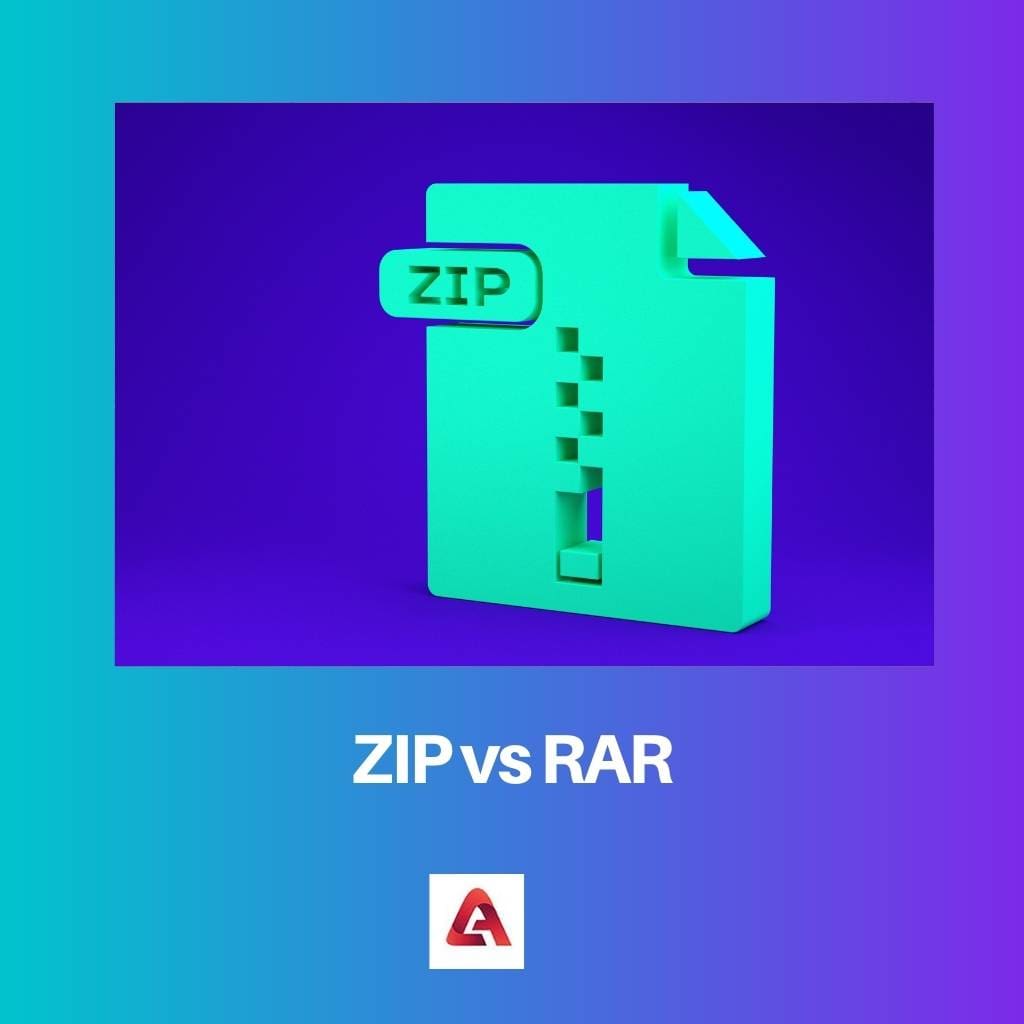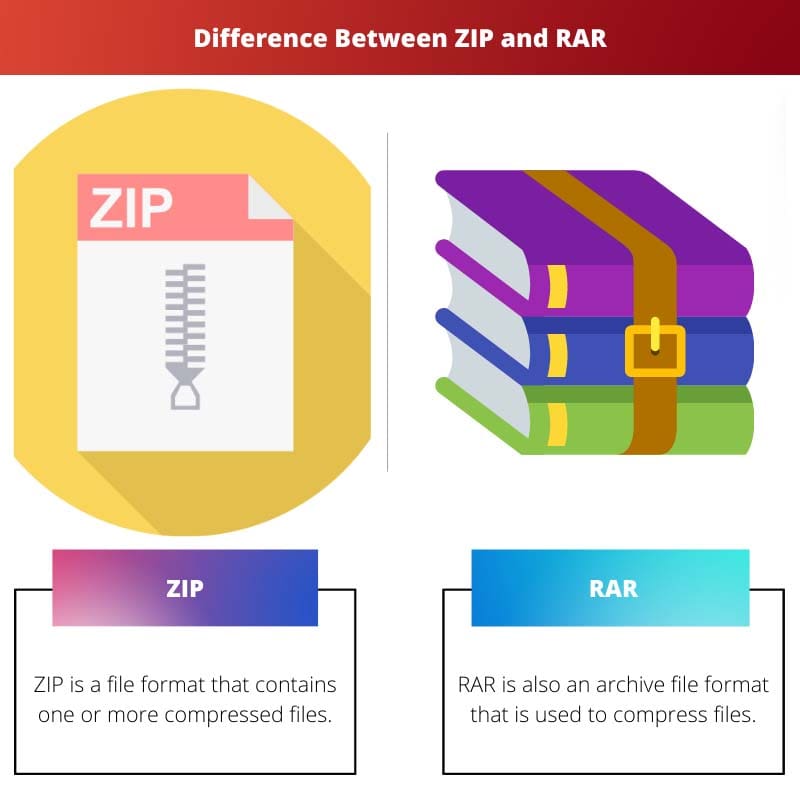ZIP and RAR are both popular compression formats, but RAR offers better compression ratios and supports advanced features like password protection and error recovery records. However, ZIP is more widely supported across various platforms and software, making it more convenient for sharing files.
Key Takeaways
- Zip and Rar are file formats used for compressing and archiving files, reducing their size for more accessible storage and transfer.
- While Zip is more commonly used and has better compatibility with various operating systems, Rar provides higher compression ratios and stronger encryption options.
- Zip and Rar have advantages and disadvantages; their choice ultimately depends on the user’s specific needs and preferences.
ZIP vs RAR
The difference between ZIP and RAR is that ZIP is free and supported everywhere, but RAR is not free, and the files can only be accessed using WinRAR. The extra charge demanded by RAR files also points to the efficiency provided by it.

Comparison Table
| Feature | ZIP | RAR |
|---|---|---|
| Format Type | Open standard, widely supported | Proprietary format, requires specific software |
| Compression | Lower compression ratio | Higher compression ratio, especially for large files |
| Encryption | Password-based encryption | Advanced encryption options (AES-256) |
| Self-extraction | Can be created as self-extracting archives | Can be created as self-extracting archives |
| Repair Functionality | Limited repair capabilities | Built-in recovery record for data recovery |
| Multi-volume Support | Limited (requires splitting tools) | Efficient multi-volume support |
| Software Compatibility | Most operating systems have built-in support | Requires specific software (e.g., WinRAR) |
| Common Use Cases | General file compression and sharing | High compression for large files or backups |
What is ZIP?
ZIP is a widely used file compression format that allows multiple files to be compressed into a single, smaller file, making it easier to store, send, and manage data. It stands for “Zipped File” and was introduced in 1989 by Phil Katz. ZIP files are commonly used for packaging and distributing files over the internet or storing files efficiently on disk space.
How ZIP Works
ZIP employs lossless compression algorithms to reduce the size of files without losing any data. It achieves this by identifying repeating patterns in the data and replacing them with shorter codes. When the ZIP file is decompressed, the original files are reconstructed exactly as they were before compression.
Features of ZIP
- Compression: ZIP uses various compression algorithms such as DEFLATE, LZMA, or BZIP2 to reduce file sizes. This compression can significantly decrease the size of files, making them easier to store and transfer.
- Archiving: ZIP allows multiple files and directories to be combined into a single archive file. This simplifies the process of organizing and sharing files, as users can group related files together into a single ZIP file.
- Encryption: ZIP supports password-based encryption, allowing users to secure their files with a password. This feature ensures that only users with the correct password can access the contents of the ZIP file.
- Cross-Platform Compatibility: ZIP files are supported by a wide range of operating systems and software applications, making them a popular choice for file compression and archiving. Whether you’re using Windows, macOS, Linux, or other platforms, you can create and extract ZIP files with ease.

What is RAR?
RAR, short for Roshal Archive, is a proprietary file format for data compression and archiving. It was developed by Eugene Roshal and is commonly used for compressing files to reduce their size for storage or transmission over the internet. RAR files are recognized by the “.rar” file extension and are created using the WinRAR software.
How RAR Works
RAR employs a combination of lossless compression algorithms, including LZSS (Lempel-Ziv-Storer-Szymanski) and LZ77, to achieve high compression ratios. These algorithms analyze the input data, identify repetitive patterns, and replace them with shorter codes, resulting in a smaller compressed file size. RAR also supports optional solid compression, where multiple files are treated as a single data block, allowing for improved compression efficiency.
Features of RAR
- High Compression Ratio: RAR offers better compression ratios compared to other compression formats like ZIP. This means that RAR files can be significantly smaller, saving storage space and reducing bandwidth usage when transferring files over the internet.
- Advanced Compression Options: RAR provides various compression options, including different compression methods and levels, allowing users to customize the compression process according to their specific requirements. This flexibility enables users to balance compression efficiency with processing time.
- File Splitting: RAR supports splitting large files into smaller parts, known as volumes. This feature is particularly useful for splitting large archives into multiple smaller files that can fit on different storage media or be transmitted more easily.
- Encryption and Security: RAR supports strong encryption algorithms, including AES (Advanced Encryption Standard) with a 256-bit key size, to secure the contents of compressed archives. Users can password-protect RAR files to prevent unauthorized access, ensuring the confidentiality of their data.

Main Differences Between ZIP and RAR
- Compression Efficiency:
- RAR offers higher compression ratios compared to ZIP, meaning RAR files are smaller in size for the same set of files.
- Features:
- RAR supports advanced features such as encryption, error recovery records, and file splitting, while ZIP offers basic compression and archiving functionalities.
- Compatibility:
- ZIP files are more widely supported across various platforms and software applications compared to RAR files, making ZIP a more convenient choice for sharing files.
- Software Requirement:
- While ZIP files can be created and extracted using built-in tools in most operating systems, RAR files require third-party software like WinRAR or 7-Zip for full compatibility and functionality.
- Licensing:
- ZIP format is open and free to use, while RAR is proprietary, requiring licensing for certain functionalities and implementations.

Conclusion
Large files can be a menace, especially if they are shared with someone or might take a while to download/upload.
To reduce the chances of such problems, ZIP and RAR were created. They help reduce the file size but keep the data in them intact.
ZIP was created in 1989, earlier than RAR and is still widely used worldwide.
The biggest advantage is that it is free. RAR was developed later in 1993 but is more efficient than ZIP.
ZIP files are also more secure than RAR files as they use a more advanced encryption algorithm.
Several programs can also create ZIP files, while WinRAR can only create RAR files. ZIP and RAR programs have the same function, but the difference lies in the execution and efficiency of compression and decompression.
Considering both advantages and disadvantages, one should choose a program based on their requirements.
- https://www.sciencedirect.com/science/article/pii/S1570866713000257
- https://brighterguide.com/best-7-zip-alternatives/